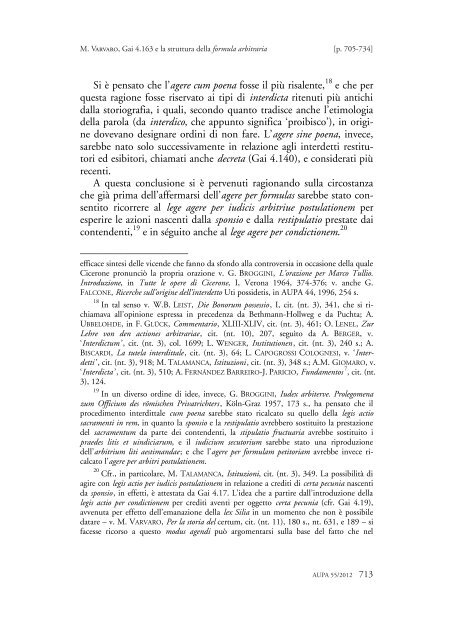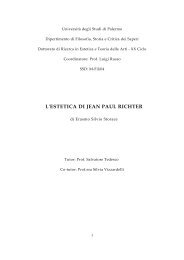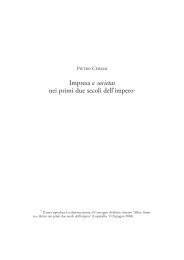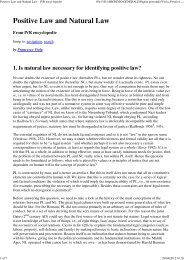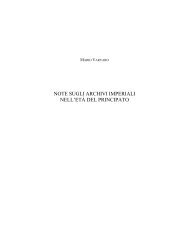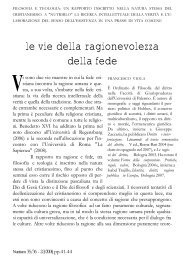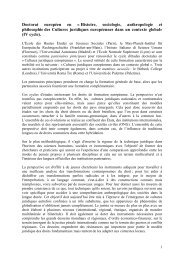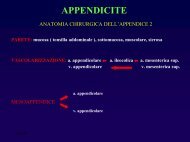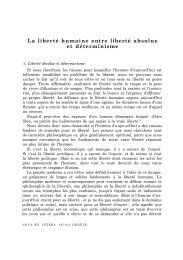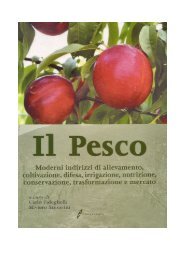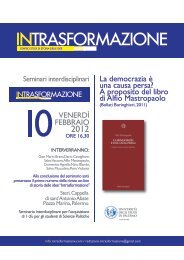M. VARVARO, Gai 4.163 e la struttura della formula arbitraria nell ...
M. VARVARO, Gai 4.163 e la struttura della formula arbitraria nell ...
M. VARVARO, Gai 4.163 e la struttura della formula arbitraria nell ...
Create successful ePaper yourself
Turn your PDF publications into a flip-book with our unique Google optimized e-Paper software.
M. Varvaro, <strong>Gai</strong> <strong>4.163</strong> e <strong>la</strong> <strong>struttura</strong> del<strong>la</strong> formu<strong>la</strong> <strong>arbitraria</strong> [p. 705-734]<br />
Si è pensato che l’agere cum poena fosse il più risalente, 18 e che per<br />
questa ragione fosse riservato ai tipi di interdicta ritenuti più antichi<br />
dal<strong>la</strong> storiografia, i quali, secondo quanto tradisce anche l’etimologia<br />
del<strong>la</strong> paro<strong>la</strong> (da interdico, che appunto significa ‘proibisco’), in origine<br />
dovevano designare ordini di non fare. L’agere sine poena, invece,<br />
sarebbe nato solo successivamente in re<strong>la</strong>zione agli interdetti restitutori<br />
ed esibitori, chiamati anche decreta (<strong>Gai</strong> 4.140), e considerati più<br />
recenti.<br />
A questa conclusione si è pervenuti ragionando sul<strong>la</strong> circostanza<br />
che già prima dell’affermarsi dell’agere per formu<strong>la</strong>s sarebbe stato consentito<br />
ricorrere al lege agere per iudicis arbitriue postu<strong>la</strong>tionem per<br />
esperire le azioni nascenti dal<strong>la</strong> sponsio e dal<strong>la</strong> restipu<strong>la</strong>tio prestate dai<br />
contendenti, 19 e in séguito anche al lege agere per condictionem. 20<br />
——————————<br />
efficace sintesi delle vicende che fanno da sfondo al<strong>la</strong> controversia in occasione del<strong>la</strong> quale<br />
Cicerone pronunciò <strong>la</strong> propria orazione v. G. BROGGINI, L’orazione per Marco Tullio.<br />
Introduzione, in Tutte le opere di Cicerone, I, Verona 1964, 374-376; v. anche G.<br />
FALCONE, Ricerche sull’origine dell’interdetto Uti possidetis, in AUPA 44, 1996, 254 s.<br />
18 In tal senso v. W.B. LEIST, Die Bonorum possessio, I, cit. (nt. 3), 341, che si richiamava<br />
all’opinione espressa in precedenza da Bethmann-Hollweg e da Puchta; A.<br />
UBBELOHDE, in F. GLÜCK, Commentario, XLIII-XLIV, cit. (nt. 3), 461; O. LENEL, Zur<br />
Lehre von den actiones <strong>arbitraria</strong>e, cit. (nt. 10), 207, seguìto da A. BERGER, v.<br />
‘Interdictum ’, cit. (nt. 3), col. 1699; L. WENGER, Institutionen, cit. (nt. 3), 240 s.; A.<br />
BISCARDI, La tute<strong>la</strong> interdittale, cit. (nt. 3), 64; L. CAPOGROSSI COLOGNESI, v. ‘Interdetti<br />
’, cit. (nt. 3), 918; M. TALAMANCA, Istituzioni, cit. (nt. 3), 348 s.; A.M. GIOMARO, v.<br />
‘Interdicta ’, cit. (nt. 3), 510; A. FERNÁNDEZ BARREIRO-J. PARICIO, Fundamentos 7 , cit. (nt.<br />
3), 124.<br />
19 In un diverso ordine di idee, invece, G. BROGGINI, Iudex arbiterve. Prolegomena<br />
zum Officium des römischen Privatrichters, Köln-Graz 1957, 173 s., ha pensato che il<br />
procedimento interdittale cum poena sarebbe stato ricalcato su quello del<strong>la</strong> legis actio<br />
sacramenti in rem, in quanto <strong>la</strong> sponsio e <strong>la</strong> restipu<strong>la</strong>tio avrebbero sostituito <strong>la</strong> prestazione<br />
del sacramentum da parte dei contendenti, <strong>la</strong> stipu<strong>la</strong>tio fructuaria avrebbe sostituito i<br />
praedes litis et uindiciarum, e il iudicium secutorium sarebbe stato una riproduzione<br />
dell’arbitrium liti aestimandae; e che l’agere per formu<strong>la</strong>m petitoriam avrebbe invece ricalcato<br />
l’agere per arbitri postu<strong>la</strong>tionem.<br />
20 Cfr., in partico<strong>la</strong>re, M. TALAMANCA, Istituzioni, cit. (nt. 3), 349. La possibilità di<br />
agire con legis actio per iudicis postu<strong>la</strong>tionem in re<strong>la</strong>zione a crediti di certa pecunia nascenti<br />
da sponsio, in effetti, è attestata da <strong>Gai</strong> 4.17. L’idea che a partire dall’introduzione del<strong>la</strong><br />
legis actio per condictionem per crediti aventi per oggetto certa pecunia (cfr. <strong>Gai</strong> 4.19),<br />
avvenuta per effetto dell’emanazione del<strong>la</strong> lex Silia in un momento che non è possibile<br />
datare – v. M. <strong>VARVARO</strong>, Per <strong>la</strong> storia del certum, cit. (nt. 11), 180 s., nt. 631, e 189 – si<br />
facesse ricorso a questo modus agendi può argomentarsi sul<strong>la</strong> base del fatto che nel<br />
AUPA 55/2012 713


